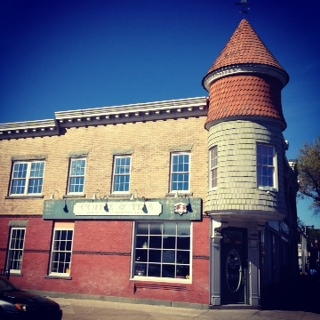Feeling adventurous, I ordered a fancy-pants coffee at Starbucks. A "lite" caramel macchiato, tall, extra foam. I could taste the artificial sweeteners in the sugar-free, vanilla syrup, but otherwise, it was pretty tasty.
Usually, I just order a cappuccino, so this was a new experience for me. But it's a regular part of many peoples' lives, and that is a stunning turn in our collective coffee consciousness.
"Words like 'macchiato,' 'cappuccino'.....people didn't know how to pronounce them ten years ago," John Moore said. He's the vice president of sales and marketing at Dallis Coffee, a wholesale coffee roaster. "Now, thanks to Starbucks, kids know them."
Never heard of Dallis Coffee? Me neither, until a few months ago. Dallis has been roasting coffee in New York City since 1913. They are wholesalers, supplying cafés and restaurants, like Café Roma, Back Forty and City Hall, as well as big institutions like NYU and Columbia University. Some of their clients have been with them for decades, as I learned in this excellent overview of Dallis in Edible Manhattan.
I was talking about the specialty coffee revolution with Moore at Dallis' headquarters in Ozone Park, Queens, in a high-ceiling room filled with different coffee machines, from boxy Bunn drips to gleaming La Marzocco espresso makers.
Dallis, Moore concedes, missed the chance to step out from behind the roasting machine and get noticed by coffee geeks during the first wave of of the boutique coffee movement. It's a wave that, Moore recalled, was swelling in New York long before Starbucks set up its first store in Manhattan in 1994.
"People say you couldn't get a good cup of coffee in New York in the early '90s, but that's not true. I had some of the greatest coffees of my life here." He mentioned Timothy's, Oren's, Porto Rico and New World Coffee, where Moore was working, roasting beans and managing a store in Summit, New Jersey. "Was it on every corner? No. Was it consistent? No. Did we have the technology and the tools to share with the public what we were doing? No But there were people paying attention."
He credits Starbucks with educating the market. "They made coffee an experience, something that people do every day. They go out for it. They made a serious effort to be sustainable. And they set the price standard," he explained.
(Photo: Dallis Coffee headquarters in Ozone Park, Queens.)
Moore knows that, depending on one's perspective and resources, a $4 cup of coffee isn't necessarily a good thing. But delivering a high-quality, consistent, cup of coffee, from the farmer to the processor to the shipper, the roaster and the barista, is difficult. And that now-typical $4 price tag reflects that.
"Everyone wants great roads, but no one wants to pay for it," said Moore.
Dallis' primary business remains a lower-cost blend that goes out to many of its clients. But it also offers the kinds of coffees that are now on hipster's lips: single-origin and micro-lot, fair trade and organic. Again, we have Starbucks to thank for this.
Moore said Starbucks paved the way for specialty coffee roasters and brewers to set up shop and offer their own take on espresso, cappuccino and macchiato. "Now," he said, "they've paved the way for differentiation."
Our conversation made me think about that caramel macchiato I bought in a whole new way.
